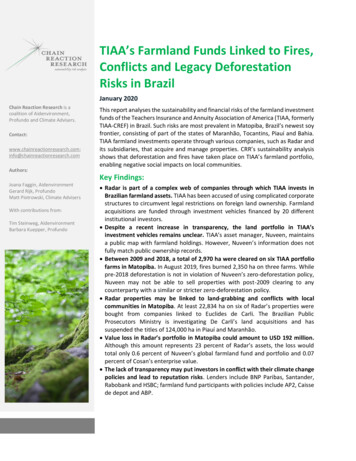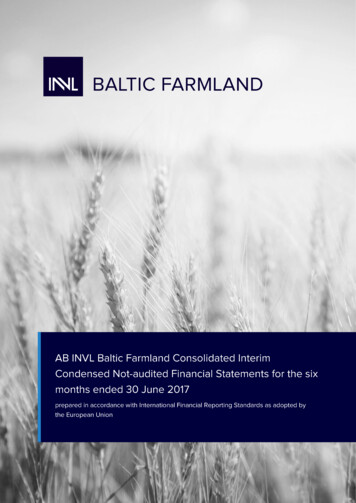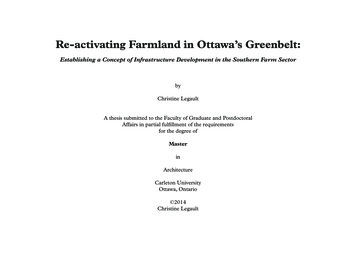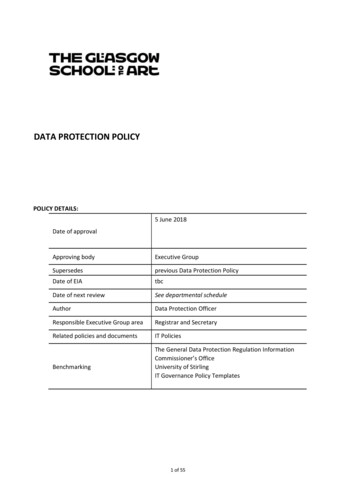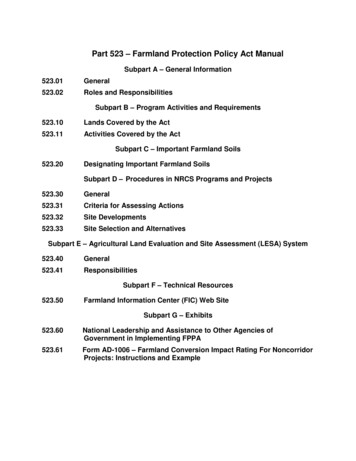
Transcription
Part 523 – Farmland Protection Policy Act ManualSubpart A – General Information523.01General523.02Roles and ResponsibilitiesSubpart B – Program Activities and Requirements523.10Lands Covered by the Act523.11Activities Covered by the ActSubpart C – Important Farmland Soils523.20Designating Important Farmland SoilsSubpart D – Procedures in NRCS Programs and Projects523.30General523.31Criteria for Assessing Actions523.32Site Developments523.33Site Selection and AlternativesSubpart E – Agricultural Land Evaluation and Site Assessment (LESA) System523.40General523.41ResponsibilitiesSubpart F – Technical Resources523.50Farmland Information Center (FIC) Web SiteSubpart G – Exhibits523.60National Leadership and Assistance to Other Agencies ofGovernment in Implementing FPPA523.61Form AD-1006 – Farmland Conversion Impact Rating For NoncorridorProjects: Instructions and Example
523.62Form NRCS-CPA-106 – Farmland Conversion Impact Rating ForCorridor-Type Projects: Instructions and Example523.63Implementation of Existing LESA System523.64Adjustment and Application of Relative Values for Specific SitesUsing the LE Part of LESA523.65Development and Use of Relative Value for Land Use Planning523.66Glossary523.67Title – 7 Agriculture, Subtitle B – Regulations of the Department ofAgriculture, Chapter VI – Natural Resources Conservation Service523.68Departmental Regulation 9500-3, Land Use Policy
Part 523 – Farmland Protection Policy ActSubpart A – General Information523.1 GeneralA. PurposeThe purpose of the Farmland Protection Policy Act (FPPA) is to—(i) Minimize the extent to which Federal programs, including technical assistance orfinancial assistance, contribute to the unnecessary and irreversible conversion ofimportant farmland to nonagricultural uses.(ii) Encourage alternative actions, if appropriate, that could lessen the adverse effects onfarmland.(iii) Assure that Federal programs are operated in a manner that, to the extent practicable,will be compatible with State, local government, and private programs that protectfarmland.B. Source of Authority(1) Law(i) The Farmland Protection Policy Act of 1981 (Public Law 97-98, December 22, 1981)(ii) Final rules published in the Federal Register on June 17, 1994(2) Regulation(i) Farmland Protection Policy Act of 1981 (Public Law 97-98, December 22, 1981)(ii) Farmland Protection Policy Act, 7 U.S.C. Part 658, July 5, 1984 (amended June 6, 1994)(iii) Prime and Unique Farmlands, 7 U.S.C. Part 657, January 31, 1978 (revised January 1,2001)(iv) Departmental Regulation 9500-3, March 22, 1983(v) National Land Evaluation and Site Assessment (LESA) Handbook, January 2012C. ScopeFPPA applies only to Federal assistance and actions that would convert important farmland tononagricultural uses. It does not authorize the Federal Government in any way to regulate the useof private or non-Federal land or in any way affect the private property rights of owners of privateland.D. Program AvailabilityThis program applies to all Federal or federally funded activities in the United States, the Districtof Columbia, the Commonwealth of Puerto Rico, the Commonwealth of the Northern MarianaIslands, the Territory of Guam, the Territory of American Samoa, the Territory of the VirginIslands, and any other territory or possession of the United States. Provisions of FPPA apply toprograms that provide financial assistance as well as to programs that provide technicalassistance.523.2 Roles and ResponsibilitiesA. GeneralNRCS is the agency responsible for ensuring that FPPA is implemented. It is the responsibilityof other Federal agencies and entities receiving Federal funds to lessen the effects of conversionactivities on farmland and to ensure that their programs or activities are compatible, to the extentpracticable, with State, local, and private programs to protect farmland.
B. General RoleUnder FPPA, NRCS will provide technical assistance to Federal agencies, State and localgovernments, Tribes, and nonprofit organizations that receive Federal funds or technicalassistance. Examples of technical assistance include the following:(i) Responding to requests for technical assistance in developing programs or policies thatlimit the conversion of productive farmland to nonagricultural uses(ii) Advising agencies when a change in law, regulation, administrative rule, or other type ofpolicy may affect the agency’s compliance with FPPA(iii) Providing site assessment criteria to governmental agencies and nonprofit organizations;(iv) Developing important farmland maps(v) Providing technical assistance during alternative site considerations, upon request byanother Federal agencyC. National Level ResponsibilitiesAt the national level, NRCS will—(i) Provide leadership in developing NRCS policy, procedures, and guidelines for conductingland evaluations (LE).(ii) Provide overall leadership for design and use of agricultural land evaluation and siteassessment (LESA).(iii) Report to Congress annually by December 15 of each year the effects of Federalprograms or federally funded programs on farmland conversion and the impact of theconversion.(iv) Provide national leadership and interpretation for implementation and evaluation ofFPPA and provide assistance to other Federal agencies in reviewing their programs anddeveloping FPPA compliance policies.(v) Work with USDA Cooperative State Resource Education and Extension Service(CSREES) and conservation districts in developing information programs to increaseFPPA awareness.(vi) Ensure that a methodology is developed and maintained for using the prime farmlandcriteria to develop lists of prime farmland soils, as needed.(vii) Hold one or more meetings with Federal agencies per year to review FPPA activities.D. State-Level ResponsibilitiesAt the State level, NRCS will—(i) Review FPPA policy and decisions with the Governor (in the case of a lawsuit broughtabout by the Governor).(ii) Respond to requests for evaluation of projects subject to provisions of FPPA.(iii) Work with CSREES to create FPPA awareness information.(iv) Make available to each field office a single, current, coordinated list of prime, unique,and statewide and locally important farmlands, in an appropriate format.(v) Participate in the planning process on projects that fall under the jurisdiction of FPPA.(vi) Review and approve desginations of statewide and locally important farmland.(vii) Develop criteria for identifying the effects of the Federal programs on the conversion offarmland to nonagricultural uses.(viii) Provide and maintain a statewide or county-level electronic list of prime farmland foruse by NRCS and the public.(ix) Provide assistance, as appropriate, in the development of land evaluation systems forState or local jurisdictions where such systems do not currently exist.
(x) Assist NRCS offices and local entities with the development of LESA systems, whereappropriate.(xi) Forward criteria for statewide important farmland to the Deputy Chief for Soil Scienceand Resource Assessment.(xii) Provide NRCS service centers or field offices with support data, such as lists of averagefarm unit size and other appropriate information.(xiii) Complete the annual NRCS-CPA-2 report by November 15 of each year based on theinformation obtained from AD-1006s and forward the data to the Soil Science Divisionstaff. (See section 523.67 for Form NRCS-CPA-2.)E. Field-Level ResponsibilitiesAt the field level, NRCS will—(i) Provide clients with maps and other soil information, where appropriate and available.(ii) Assist Federal agencies or other entities receiving Federal assistance in completing AD1006 (see section 523.61) or NRCS-CPA-106 (see section 523.62), where applicable.(iii) Provide to the State’s FPPA program manager, based on AD-1006 submissions, asummary of activities related to farmland protection and assistance in completing theNRCS-CPA-2 annual report.(iv) Maintain and forward to the State office a list of prime, unique, and statewide andlocally important farmland soils and the criteria designating such soil map units for theoffice service area.(v) Provide clients with information, such as data on high-value crops, to assist in theidentification and delineation of statewide, unique, or locally important farmland.F. Other Federal Agency RolesIt is the Federal agency’s responsibility to—(i) Identify and take into account the adverse effects of Federal programs on the preservationof farmland.(ii) Consider alternative actions that could lessen the effects of farmland conversion.(iii) Mitigate adverse effects where practicable, including taking action to avoid impact,minimize impact, and repair or reduce impact, or compensate for the impact by replacingor substituting important farmland acres.(iv) Assure that Federal programs are compatible with State, local government, and privatefarmland protection programs.(v) Review agency policies and authorizing legislation to ensure that they comply withFPPA.(vi) Develop proposals for action so that programs, authorities, regulations, and policies arein compliance with FPPA.(vii) Determine if a project is converting farmland (if agencies are uncertain whether they areconverting farmland, they should contact the local NRCS field office nearest to theproposed project.(viii) Report the possible alternatives actions and the final project decision to the NRCS fieldoffice where the project is proposed.(ix) Report progress on the abovementioned items to the assisting NRCS field office byNovember 15 of each year.G. Role of State GovernorThe Governor of an affected State (where State farmland protection programs or policy exist)may bring suit against a Federal agency whose project, program, or other activity negatively
affects farmland. The Governor may bring an action in the Federal district court of the districtwhere a Federal program is proposed.Note: A Governor of an affected State has the ability to bring suit against a Federal agency that isconverting farmland but individuals, State governments, local units of government, andnongovernmental organizations may not challenge such an activity in court.
Part 523 – Farmland Protection Policy ActSubpart B – Program Activities and Requirements523.10 Lands Covered by the ActA. Lands Subject to Provisions of FPPAImportant farmlands, including lands identified with soils that are prime, unique, or statewide orlocally important farmland, are subject to the provisions of the Farmland Protection Policy Act.B. Lands Not Subject to Provisions of FPPAThe following lands are not covered by the act:(i) Lands that receive a combined score of less than 160 points from the Land Evaluation andSite Assessment (LESA) criteria(ii) Lands identified as “urbanized area” (UA) on Census Bureau maps(iii) Land with a “tint overprint” on the U.S. Geographical Survey topographical map(iv) Areas shown as white (not farmland) on USDA important farmland maps (these are sitesthat do not contain prime, unique, statewide important, or locally important farmland)(v) Areas shown as “urban-built up” on USDA important farmland maps (this is consistentwith the guidance of the National Resources Inventory (NRI) for mapping urban built-upareas. Note: Areas 10 acres or larger without structures are not considered urban built-upand are subject to FPPA)(vi) Land in water storage, including lands that have been acquired or planned for waterstorage prior to August 5, 1984 (see section 523.11C)(vii) Lands that are used for national defense purposes during a national emergency (see 7U.S.C. Section 4208)(viii) Private land where no Federal funds or technical assistance is utilized523.11 Activities Covered by the ActA. Activities Subject to Provisions of FPPAActivities subject to FPPA requirements include any projects that may permanently convert(either directly or indirectly) farmland, as defined under the 1981 act and the final rules publishedin 1994, to nonagricultural use and are completed by a Federal agency or completed withfinancial or technical assistance from a Federal agency. These activities include the following:(i) Acquiring or disposing of land(ii) Providing financing or loans(iii) Managing property (i.e., national parks and national forests)(iv) Providing technical assistanceB. Specific Activities Subject to Provisions of FPPAThese activities include the following:(i) State highway construction projects (Federal assistance is funded by the Department ofTransportation)(ii) Airport expansions(iii) Electric cooperative construction projects(iv) Housing projects (Federal assistance is funded by the Federal Housing Authority)(v) Reservoir and hydroelectric projects
(vi) Dam or levee construction(vii) Permanent easements where no agricultural activity is allowed(viii) Other projects completed with technical or financial assistance from a Federal agencyC. Activities Not Subject to Provisions of FPPAThese activities include the following:(i) Federal permitting and licensing(ii) Projects planned and competed without the assistance of a Federal agency(iii) Projects planned or constructed prior to August 4, 1984 (FPPA, Part 658)(iv) Projects on land already in urban development or used for water storage(v) Construction within an existing right-of-way purchased on or before August 4, 1984(vi) Construction for national defense purposes during a national emergency (see 7 U.S.C.Section 4208)(vii) Construction of on-farm structures necessary for farm operations (e.g., barns, livestockwatering facilities, ponds, and manure management structures)(viii) Surface mining, where restoration to agricultural use is planned(ix) Construction of minor ancillary structures, such as garages and storage sheds(x) Restoration, maintenance, renovation, or replacement of existing structures prior to thetime of Federal assistance(xi) Temporary custody of land due to delinquent taxes, the exercise of conservatorship orreceivorship, or criminal law enforcement seizure or forfeitureD. Exemptions of Projects Prior to August 4, 1984These exemptions were established in FPPA, Part 658. FPPA does not apply to projects if one ormore of the following took place before August 4, 1984:(i) Construction or improvement projects had progressed beyond the planning state and werein either the active design or construction state.(ii) Loans had been secured.(iii) Acquisition of land or easements had occurred and all Federal agency planningdocuments and steps had been completed and accepted, endorsed, or approved by theappropriate agency.(iv) A final environmental impact statement had been filed with EPA.(v) The engineering or architectural design had begun or such services had been secured bycontract.E. Other Exemptions(1) Small acreages (i.e., 10 acres or less per linear mile or 3 acres where there is a project for anexisting bridge or interchange) where a statewide, local, or tribal LESA system has beenapproved by the State Conservationist. Acreage includes both direct and indirectconversions. These exemptions are to avoid new construction and encourage improvementsto existing linear projects, such as highways.(2) Corridor subsurface projects (such as buried water, sewage, or electrical lines) that willdevelop a soil disturbance/removal and reconstruction plan (as defined in 30 CFR Sections823.12 and 823.14) for all agricultural land uses. If a project is in cropland, as defined byUSDA-NRCS, 30 CFR Section 823.15 applies and a soil disturbance/removal andreconstruction plan will be developed.
Part 523 – Farmland Protection Policy ActSubpart C – Important Farmland Soils530.20 Designating Important Farmland SoilsA. Defining Farmland Subject to Provisions of Farmland Protection Policy Act (FPPA)(1) In accordance with the 1981 act (Public Law 97-98), important farmland includes all landthat is defined as prime, unique, or statewide or locally important. 7 U.S.C. Section 657.5defines these farmlands based on soil types. The identification of important farmlands will bedetermined from currently published or interim soil survey maps and data produced andcertified by the NRCS National Cooperative Soil Survey Program.(2) Soil map units with components of prime farmland are defined as follows. All other soil mapunits should be shown as not important farmland, unless they are unique farmland.(i) Prime Farmland.—Fifty percent or more of the components in the map unit are primefarmland.(ii) Farmland of Statewide Importance.—Less than 50 percent of the components in the mapunit are prime farmland, but the combination of prime farmland and farmland ofstatewide importance is 50 percent or more of the map unit.(iii) Farmland of Local Importance.—Less than 50 percent of the components in the mapunit are prime farmland or farmland of statewide importance, but the total of primefarmland and farmland of statewide or local importance is 50 percent or more of the mapunit.(3) The following table identifies what is considered important farmland in accordance with the1981 act. The paragraphs that follow identify the procedures used to determine thesefarmlands.Figure 523-C1Is. . .As defined by the 1981 act, farmland:Is Not. . .Prime farmlandLand identified as urban according toCensus Bureau mapsUnique farmlandFarmland of statewide or local importancePastureland, cropland, forestland, and other landthat is not urban land or waterAll farmland and forestland meeting the criteria forprime, unique, or statewide or locally importantfarmland, even if zoned for developmentLand identified as urban according toUSDA Important FarmlandMapsLand identified as urban according toUSGS topographic mapsLand committed to water storageB. Designating Prime Farmland SoilsPrime farmland is land that has the best combination of physical and chemical characteristics forproducing food, feed, forage, fiber, and oilseed crops and is also available for these uses. Theland could be cropland, pastureland, rangeland, forestland, or other land but not urban built-up
land or water. Lists of prime farmland soils will be developed by NRCS according to criteria inUSDA Departmental Regulation (DR) 9500-3, dated March 22, 1983, and 7 CFR Section 657.5.C. Designating Unique Farmland SoilsUnique farmland is land other than prime farmland that is used for the production of specifichigh-value food and fiber crops. It has the special combination of soil quality, location, growingseason, and moisture supply needed to economically produce sustained high quality or high yieldsof a specific crop when treated and managed according to acceptable farming methods and otherconditions, such as nearness to market, that favor the growth of a specific food or fiber crop.Examples of such crops are red tart cherries (click here for the Red Tart Cherry Site Inventory forGrand Traverse County, MI), citrus, tree nuts, olives, cranberries, fruit, and vegetables. Uniquefarmland will be created based on criteria outlined in DR 9500-3 and 7 CFR Section 657.5.D. Designating Farmland of Statewide ImportanceThis is land, in addition to prime and unique farmlands, that is of statewide importance for theproduction of food, feed, fiber, forage, and oil seed crops (7 CFR Section 657.5). The Stategovernment, (i.e., the office of the State Secretary of Agriculture or a higher office) mustdesignate farmland of statewide importance. The NRCS State Conservationist must concur withthis designation in order for it to apply to FPPA.E. Designating Farmland of Local ImportanceIn some local areas, certain additional farmlands are important for the production of food, feed,fiber, forage, and oilseed crops even though these lands are not identified as having national orstatewide importance. Where appropriate, these lands are to be identified by the local agency oragencies concerned. Additional farmlands of local importance may include tracts of land thathave been designated for agriculture by local ordinance. A local unit of government, as defined in7 CFR Section 657.5, must designate farmland of local importance. The NRCS StateConservationist must concur with this designation in order for it to apply to FPPA.F. Designating Prime Rangeland and Rangeland or Grassland of Statewide Importance(1) Prime rangeland is rangeland that, because of its soil, climate, topography, vegetation, andlocation, has the highest quality or value for grazing animals. The potential naturalvegetation is palatable, nutritious, and available to the kinds of herbivores common to thearea. The prime rangeland designation is based on criteria outlined in DR 9500-3. (Seesection 523.68.)(2) Rangeland or grassland of statewide importance also has high quality or value for grazinganimals. The State government, (i.e., the office of the State secretary of agriculture or ahigher office) must designate rangeland or grassland of statewide importance. The NRCSState Conservationist must concur with this designation in order for it to apply to Federalfarmland protection.
Part 523 – Farmland Protection Policy ActSubpart D – Procedures for NRCS Programs and Projects523.30 GeneralA. PurposeThis part describes procedures for compliance with the Farmland Protection Policy Act (FPPA),subtitle I of title XV of the Agricultural and Food Act of 1981 (Public Law 97-98), and theDepartment's land use policy, Departmental Regulation (DR) 9500-3. This part also citesrequirements for NRCS compliance with the Coastal Zone Management Act.B. NRCS Compliance Policy(1) NRCS will follow all the Federal policies as stated in FPPA, DR 9500-3, and provisions ofthe Coastal Management Act of 1972 requiring that Federal actions be consistent withapproved State coastal zone management programs. The specific assignments applicable toNRCS are found in—(i) DR 9500.3(6)(d) (responsibilities).(ii) FPPA Sections 1540, 1541(b), 1542, and 1543.(iii) FPPA Part 658.(2) National Headquarters will review current provisions of laws, administrative rules andregulations, and policies and procedures to determine if NRCS is compliant with FPPA andDR 9500-3. NRCS will propose any changes in the internal policy and procedure.(3) In developing project or measure plans or in assisting planning, NRCS personnel will exploreall reasonable alternative sites, designs, or actions that could meet the purposes of theproposed project. They will evaluate all alternatives involving farmland conversions as wellas evaluate the potential for using nonfarmland corridors or sites.(4) NRCS will comply with Federal requirements to ensure that projects are consistent withcoastal zone management programs of State and local governments that have been approvedby the Department of Commerce.C. ApplicabilityThe policies set forth in Title 430, National Soil Survey Handbook (NSSH), Part 601, Section601.1, apply to NRCS technical and financial assistance that may result in farmland conversion tononagricultural uses and to all proposed actions located in coastal zones that have an approvedState coastal zone management program.523.31 Criteria for Assessing ActionsA. NRCS will evaluate all proposed assistance to determine if FPPA or DR 9500-3 applies. Theevaluation will be done as part of the environmental assessment process under the NationalEnvironmental Policy Act. In all cases, the evaluation will be made early in the planning stage,before final location and design decisions are made. Forms AD-1006 and NRCS-CPA-106 will beused.B. NRCS assistance in the planning and application of conservation treatment and in the design offacilities necessary for the operation of a farm unit is not covered by FPPA or DR 9500-3 and will notbe evaluated because these actions will not convert farmland to nonagricultural use.C. When NRCS assistance is provided and it is determined that conversion of farmland tononagricultural use will occur, NRCS will evaluate alternative sites or designs.
(1) A local land evaluation (LE) system using criteria in FPPA, Part 658, Section 658.4(a), willbe used to evaluate all alternatives located within one local government's jurisdiction. Whenalternatives occur in multigovernmental jurisdictions, an appropriate regional or State landevaluation system will be used.(2) Use of site assessments:(i) Where a site assessment system (a complete land evaluation and site assessment (LESA))has been placed on the State Conservationist's list of systems meeting the purpose ofFPPA, that local system will be used.(ii) If no local site assessment system exists, or if the area of consideration is larger than thatof the available local approved site assessment system, an available regional or State siteassessment system that has been placed on the State Conservationist's list of systemsmeeting the purpose of the FPPA will be used.(iii) When a site is to be evaluated where an approved site assessment system is not availableat the local, regional, or State level, NRCS will use the site assessment criteria set forth inFPPA, Part 658. Only those site or design alternatives that meet the stated purpose of theproject will be evaluated for farmland protection.523.32 Site DevelopmentsA. Site-Specific DevelopmentsSite-specific developments are localized, self-contained, nonlinear projects that come under thecriteria in FPPA Section 658.5(b) in the evaluation of direct and indirect farmland conversions.Each of the 12 site assessment criteria will have the weighting shown in section 658.5(b). Duringthe planning process, care should be taken to consider alternative sites whenever farmland will beconverted by a proposed action.B. Corridor DevelopmentsCorridor-type developments include projects designed to carry services or materials between twodistant points and stream improvements or flood-control projects that change farmland use.Modifications of the criteria as shown in FPPA Section 658.5(c) will be used to evaluate thecorridor-type site projects.C. Single SitesIn the case of dams, the entire site, including spillways, the pool area, and other appurtenances,will be considered in the evaluation. Each alternative location or each design at the same locationthat is evaluated for engineering or economic purposes (when the design would affect a differentamount of farmland) will also be evaluated for farmland protection.D. Multiple Sites(1) For planning purposes, where multiple sites exist in a watershed project, the farmlandprotection evaluation can be carried out using a sampling procedure if any of the followingapply:(i) The major purpose of the project is watershed protection or flood control.(ii) A large number of structures (more than 15) are used to alleviate the problem.(iii) Sampling procedures are being used to evaluate any other resources.(2) Any sampling procedure should take into account all of the different site conditions that mayexist. If the land evaluation appears to be uniform for a given number of sites, one score thatis representative of the group should be developed. The number of representative samplesshould be at least 5 percent for each group.
(3) Each alternative considered in the environmental impact statement (EIS) of a watershed planshould have been evaluated for farmland protection, and the results of the evaluation shownin the discussion of the alternative. This will allow the cumulative impacts of eachalternative to be judged and considered in the decisionmaking process.523.33 Site Selection and AlternativesA. For site-specific projects, if the total of points according to the LESA criteria is less than 160, noother alternatives need be considered. If the total of points is between 160 and 220, at least two otheralternatives need to be evaluated and the one with the lowest number of points selected unless thereare other overriding considerations. In these cases, documentation should clearly show why thealternative with the higher total of points was selected and explain any other overridingconsiderations.B. For site-specific projects, if the total of points according to the LESA criteria is greater than 220,three other alternatives should be evaluated and the one with the lowest total of points selected unlessthere are other overriding considerations. If additional reasonable alternatives are not readilyavailable, this should be documented.C. For corridor-type projects, the alternative with the lowest number of points should be selected.D. Watershed projects will be evaluated on the basis of alternative plans consisting of multiple sitesrather than individual sites. In selecting the recommended plan, all factors required by law must beconsidered and evaluated.E. The farmland most suitable for protection under these criteria will receive the highest total ofpoints, and farmland least suitable the lowest total. In evaluating sites, NRCS will consider—(1) Alternative sites, locations, and designs that would serve the proposed purpose but converteither fewer acres of farmland or other farmland that has a lower relative value.(2) Use of land that is not farmland or use of existing structures.(3) Special siting requirements of the proposed project and the extent to which each alternativesite meets these requirements.F. In making decisions for farmland protection for sites with LESA scores of 160 points or more,NRCS should consider terminating all assistance, both technical and financial, when the evaluationdemonstrates an adverse effect on farmland and the entity will not accept alternatives that would haveless impact and when acceptable alternatives are found and there are more benefits from protectingthe farmland than from the proposed conversion project.
Part 523 – Farmland Protection Policy ActSubpart E – Agricultural Land Evaluation and Site Assessment (LESA) System523.40 GeneralA. Purpose(1) This part establishes NRCS policy for providing information and technical assistance todevelop State, local, and Tribal LESA systems. Procedures for developing LESA systemswith local units of government are contained in Title 430, National Soil Survey Handbook(NSSH), Part 601. LESA systems developed for
523.62 Form NRCS-CPA-106 - Farmland Conversion Impact Rating For Corridor-Type Projects: Instructions and Example 523.63 Implementation of Existing LESA System . Activities subject to FPPA requirements include any projects that may permanently convert (either directly or indirectly) farmland, as defined under the 1981 act and the final .



